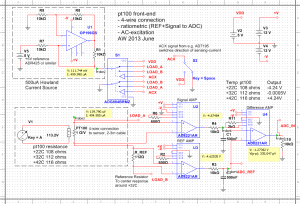Here's a sketch for a pt100/RTD frontend circuit.
There are a couple of ideas here which should improve precision:
- 4-wire connection, to eliminate lead-resistance effects
- Ratiometric measurement (both a reference and the signal go to the ADC). This should minimize effects from fluctuations in the sensing current.
- AC-excitation. The sensing current can be reversed with at TTL logic signal. Some ADC chips have an output for this, and they average the measurement done with current flowing in both directions. This eliminates effects from DC-offsets (thermovoltages etc).
- The circuit is centered around a particular temperature (here +32C) and the signals amplified so a twenty degree span of +22C to +42C should give about +/- 4 V output.
NI Multisim file for this: pt100_sensor_circuit_v3

I would suggest the "improved" howland. It is more stable.
http://electronicdesign.com/power/whats-all-current-source-stuff-anyhow
http://www.ti.com/lit/an/snoa474a/snoa474a.pdf
(the app note is another bob pease. ti stripped his name off of it and re-flowed the text in an ugly way)
Also I suggest planing on an extra set of pads on the PCB in parallel with R8. Howland's are notorious for stability issues and if all else fails you can always just tack a little bit of added resistance in parallel with R8 to make the negative feedback a hair more than the positive. Yes this makes things a little less linear (voltage in / current out) but you are only using the device as a fixed DC current source.
Thanks for the comment! I haven't built a Howland current source so I have no practical experience with them. I'll probably put a standard 10ppm/C (or so) voltage reference on the Howland input, so that should keep things stable enough - and the ADC should measure ratiometrically.
Some issues:
-The op-amp in the Howland current source was just a random pick, not sure what is best to use there.
-The ADG884 seems to "leak" about 4-5 uA of current which is output by the op-amp but does not make its way into the pt100. I don't want a mechanical relay however since this board should run for years (I hope!)
-Not sure about the instrumentation amp either - another chip might be better?
-As such the ADC_REF is not useable with AD7195, since the AD7195 wants differential REF+ and REF- inputs, both of which should stay between GND and +5V (AVDD) in absolute terms.
With ACX=hi we'd want REF+ = 4.5 V (say) and REF- = 0 V,
with ACX=lo we'd want REF+= 0V and REF-=4.5V
(in both cases the non-zero voltage should be derived from the sensing current)
A solution for REF+/REF- using another 2xSPDT switch seems a bit ugly...